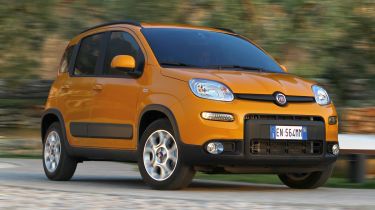Fiat Panda Trekking
The new Panda 4x4 is available as a two-wheel-drive model, too. But is it the one to go for?

As tiny off-roaders, the Panda 4x4 and Trekking models offer something unique in the market. They're both well equipped and look great, with their mini-Land Rover looks. Both have plenty of character, too. But if you like the looks and kit of the 4x4, but want to keep an eye on costs and don’t have quite the same urge to go off-roading, then the Trekking is an even better bet than the flagship 4x4 model.
The Fiat Panda 4x4 remains the only car in Fiat’s or any other carmaker’s line-up, to cram four-wheel drive into a supermini. However, if you like the baby-Land Rover looks that the Panda 4x4 has to offer but want even lower running costs, then the front-wheel-drive Panda Trekking could be right up your street.
Fiat calls the Trekking a CUV – City Utility Vehicle – which bridges the gap between the flagship 4x4 and the rest of the regular Panda supermini range.
Like the 4x4, the Panda Trekking offers a choice of either a 74bhp 1.3-litre MultiJet diesel engine, or 875cc two-cylinder TwinAir turbocharged petrol. The diesel engine comes with a five-speed gearbox, rather than the new six-speed unit that the petrol car gets.
The diesel engine is certainly quite vocal, barking away under the bonnet, where the petrol fizzes away, sounding more like a scooter than a car.
Used - available now

2017 Ford
Fiesta
38,600 milesManualPetrol1.2L
Cash £6,100
2016 Tesla
Model S
78,000 milesAutomaticElectric
Cash £18,999
2022 Volvo
XC40
17,576 milesAutomaticPetrol1.5L
Cash £25,999
2021 Kia
Sportage
44,151 milesManualDiesel1.6L
Cash £14,697The diesel unit is louder on the move, too, which is exacerbated by the fact that the wind whistles around the base of the A-pillars and the wing mirrors at higher speeds on all Panda 4x4 and Trekking models.
There’s decent torque on offer from the diesel, though. Fiat has raised the torque from 145Nm to 190Nm, and it has no problem offering strong acceleration, as well as decent low-speed urge when off-roading.
We only had the chance to drive the Trekking on a short route at Fiat’s Balocco Test Track, which included tarmac, gravel and offset log sections. However, that was long enough to realize that the Trekking is pretty much identical to the 4x4 in the way it drives. The ride height is raised by 47mm, just like the 4x4, and the extra suspension travel gives a very comfortable ride whether on road or off it.
As well as more grippy tyres, the Trekking has a special Traction+ system on the front axles, which uses the brakes to stop wheels slipping and direct traction to the wheel with more grip. That means that the Trekking has very similar off-road performance to the 4x4, too.
The Trekking will be around £1,500 cheaper than the 4x4 model, but comes with the same high equipment list as standard. What’s more, as well as removing the extra complexity of the four-wheel-drive system, the diesel Trekking is 80kg lighter than the equivalent Panda 4x4, improving fuel economy and making it cheaper to run. The range is better, too, which could be an issue as both cars feature tiny 35-litre fuel tanks.







